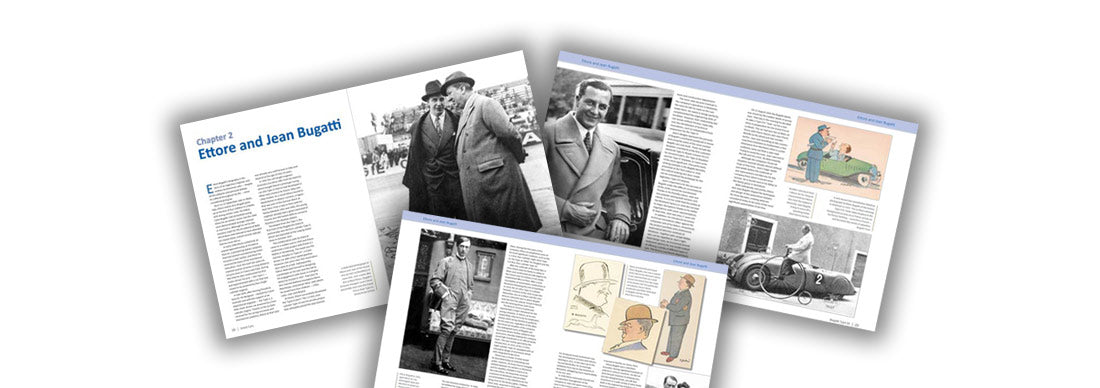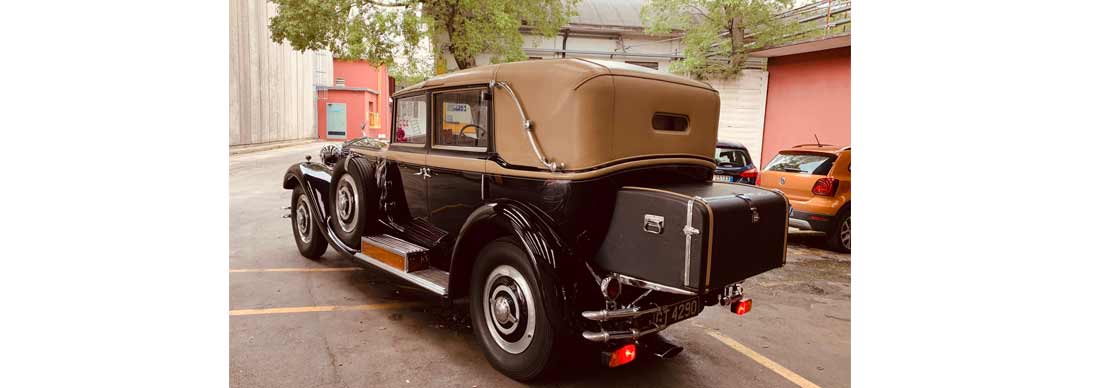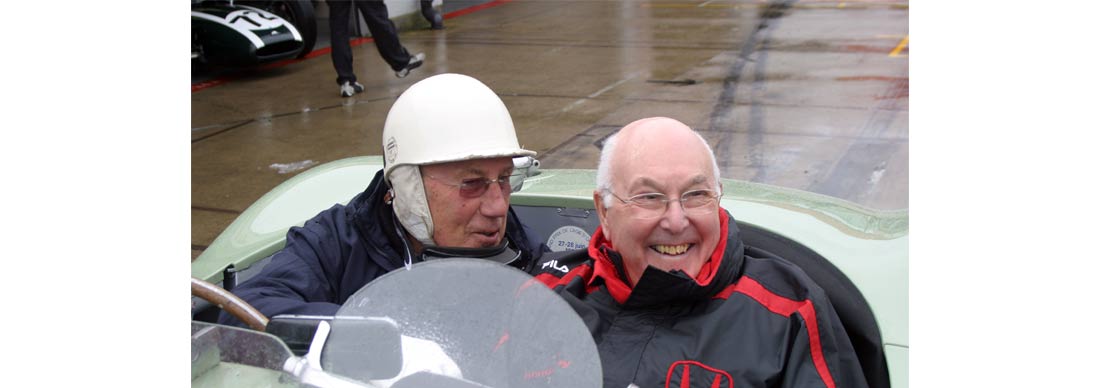
Ettore and Jean Bugatti, by Mark Morris and Julius Kruta
Extract taken from Bugatti Type 50 - The autobiography of Bugatti's first Le Mans car, by Mark Morris and Julius Kruta
Ettore Bugatti’s biography is the story of an ingenious engineer and restless businessman who — despite all the setbacks and personal defeats he suffered throughout his life — never considered giving up.
Born on 15 September 1881 in Milan, Italy, Ettore Isidoro Arco Bugatti grew up as the first of four children in a family with strong artistic roots. His father, Carlo Bugatti, had earmarked young Ettore for an artistic career, but the child soon demonstrated stronger interest in mechanics. Although he sat for the entrance exam for the Accademia di Belle Arti di Brera and claimed to have attended art classes there, school records indicate that he never did so.
In early 1898 Ettore undertook an unpaid apprenticeship at Prinetti & Stucchi, a pioneering Italian company that had started manufacturing motor tricycles a year earlier, and there he received the basis of his mechanical education. Over the next two years he claimed several victories in long-distance tricycle races in France and Italy. During this time he also constructed his first motor-driven tricycle — the Type 1 — and experimented with a car that was meant to be powered by four single-cylinder engines.
In late 1900, after leaving Prinetti & Stucchi, he designed — backed by Count Gulinelli and with the support of an experienced engineer — the Type 2, a little chain-driven car powered by a four-cylinder engine. Thanks to the acclaim received for his racing successes and mechanical creations, Ettore at that time was already very well-known in Italy and beyond at the age of only 19 years.
In 1902 the self-taught engineer received a lucrative offer from De Dietrich, which bought Ettore’s prototype racing car (the Type 3) that he had developed in Milan and a licence for future 10hp and 15hp models. As a result Ettore moved to Niederbronn in Alsace-Lorraine, a region that was part of the German Reich at that time. From a stay in Paris with his family between 1892 and 1896, the young engineer already had a good command of French, but still lacked skills to converse fluently in the Alsatian dialect.
Developed from the Type 3, the first fruit of the Bugatti/De Dietrich partnership was the four-cylinder Type 4, which was launched at the Leipzig motor show in October 1902.
The collaboration with De Dietrich came to a sudden end in 1904 and Ettore undertook a new project with Émile E.C. Mathis in Strasbourg. The result was the Hermès-Simplex or Type 6/7, a chain-driven car with a four-speed gearbox. However, two years later this association also came to a halt. Subsequently, Ettore dedicated himself to designing a prototype on his own and this led to his engagement with Deutz in Cologne, where he moved in 1907. That year he also married Barbara Giuseppina Maria Mascherpa, nicknamed ‘Rina’, with whom he would have four children — L’Ébé, Lidia, Jean and Roland.
At Deutz, Ettore successfully developed the Types 8 and 9. The 1.2-litre, four-cylinder Type 10 was his private project that ultimately paved the way towards his own business endeavour. In 1909 he fulfilled his long-cherished dream of founding his own company.

Above: (photo) A dedicated photograph of Ettore and Jean at the Grand Prix de l’ACF at Montlhéry in June 1931. Just a week after the Le Mans fiasco, Bugatti’s fortunes changed: Louis Chiron and Achille Varzi won the Grand Prix in their Type 51. Copyright: Hucke/Kruta Archive

Above: (left) Ettore Bugatti in 1901, aged about 20. His extravagant style and attention to detail are clearly evident in this photograph. Copyright Hucke/Kruta Archive
(top right) Many caricaturists portrayed Ettore Bugatti, who was a superb victim due to his extrovert nature. It was reported that you could discern his mood from the angle of his bowler hat! One particular caricaturist, Oscar Fabrès, produced a portfolio dedicated to Bugatti and his clients. Copyright Mark Morris Archive.
(bottom right) Ettore Bugatti at the wheel of the prototype Type 35 with his son Jean, in August 1924 at the Grand Prix d’Europe in Lyon. Copyright Hucke/Kruta Archive.
The premises of a former dye works in Molsheim appeared to be the ideal location but it was not until 1920 that Bugatti acquired the land and buildings there. During the first years of his company, Ettore accomplished some of his most significant creations, such as the 1.3-litre, four-cylinder, eight-valve Type 13, the Type 16 ‘Bébé’ for Peugeot and the 5.0-litre, four-cylinder Type 18.
After the outbreak of the Great War in 1914, Ettore took his family to safety in Milan and constructed aircraft engines for the French and US military in his newly established office in Paris. After a slow resumption of automobile construction in Molsheim following the end of hostilities in 1918, the 16-valve Type 13 claimed fantastic victories at the 1920 Coupe des Voiturettes race at Le Mans and the 1921 Brescia voiturette race in which Bugatti took the first four places. Ernest Friderich was the winning driver both times.
The Brescia victory in particular represented a major milestone for the young company. Le Patron, as he was respectfully referred to by his employees, always used racing cleverly as publicity for his road cars, regardless of the often dire financial situation of his company. The widespread entry of Bugatti cars by private drivers further added to their promotion, thereby helping the company avoid high investment in its official works team. This was mainly spurred by the introduction, in 1924, of the 2.0-litre, eight-cylinder Type 35, equipped with an
innovative design of aluminium wheel with integrated brake drum.
Ettore was a master of what would be described today as networking and public relations. He knew how to navigate skilfully between his workers in Molsheim and his wealthy clientele in Paris or on the Côte d’Azur. He frequently received customers to Molsheim and provided accommodation in the Hôtellerie du Pur Sang close to the factory gates. Château Saint Jean, acquired in 1928, later provided the ideal setting for customer receptions and press photographs of the latest Bugatti models. He maintained friendly relationships not only with customers but also with important journalists and influential figures from the highest circles in Paris. Ettore’s last important project with his strong personal involvement was the development of trains and railcars, starting in 1931. In the years up to the Second World War, he increasingly withdrew from day-to-day business in Molsheim, delegating more responsibility to his son Jean.
In 1936 Ettore eventually transferred the operative management of the company to Jean and spent most of his time in the French capital. During the war he dedicated himself to new automotive designs in his Paris office. After the end of hostilities he fought long and hard to reclaim the Molsheim factory that he had been forced to sell during the war.
After the death of Barbara in 1944, Ettore remarried in 1946. With Geneviève Marguerite Delcuze he had two children, Thérèse and Michel. After suffering a stroke and spending several months in a coma, Ettore died on 21 August 1947 and is buried in Neuilly-sur-Seine, Paris. Ettore Bugatti was a relentless innovator, having registered hundreds of patents in various countries. He did not limit himself, however, to drawing cars, but also designed boats, aircraft and inventions in a wide variety of other fields. Both in his engineering solutions and business relations, he was pragmatic.
The history of the Bugatti company, however, would be incomplete without proper consideration of the brilliance of Jean Bugatti.
Gianoberto Carlo Rembrandt Ettore Bugatti was born on 14 January 1909 in Cologne. At the age of 11, Jean, as he was known, began a three-year apprenticeship at the Molsheim factory. By 1932, he was director of Bugatti’s works racing team and construction department.
The more Jean became involved in the company’s operations in Molsheim, the more he left his mark on the cars made there. His talent in design perfectly complemented the engineering skills of his father. However, their relationship did not remain without friction, especially over the introduction of technical innovations, such as independent front suspension for the Type 57.

Above: (left) Jean Bugatti leaning against a Type 55 Coupé circa 1932, at the age of about 23. Copyright Hucke/Kruta Archive
(top right) Another caricature from L’Album du Pur Sang de L’Automobile by Fabrès: this time the subject is obviously Jean Bugatti, trying to wave off a speeding ticket. Copyright Mark Morris Archive
(bottom right) A well-known but nonetheless fabulous photograph of Ettore Bugatti at the factory in Molsheim in 1937. The Le Mans-winning Type 57G ‘Tank’ takes its place in the background as soon as Le Patron arrives on his Penny Farthing — grand bi in French — and becomes the centre of attention. Copyright Bugatti Trust
Jean’s designs represent the pinnacle of Bugatti’s coachwork produced in-house and comprise some of the most coveted Bugatti cars ever built. These include the Roadster coachwork of the first customer delivered Type 41 Royale (chassis 41111) for Armand Esders, the Type 55 Roadster and the Type 57 Atalante, to name some of the most significant. One particularly striking example is the Bugatti Aérolithe, presented at the Paris Salon in 1935: this radical-looking two-door coupé can be considered the prototype for the legendary Type 57S Atlantic.
Jean’s importance for the survival of Bugatti under the difficult circumstances of the 1930s cannot be overstressed. Thanks to his friendly nature, Jean was very popular among both workers and clients. It is to his credit that the strikes at the Molsheim factory in 1936 did not lead to major disruptions thanks to his skilful negotiations with union representatives. At that time, Jean was only 27 years old.
In addition, he introduced necessary technical innovations (often against the outspoken will of his father), streamlined the product portfolio and continuously improved production methods at Molsheim. Together with Joseph Walter, who can be regarded as Jean’s right-hand design man, he envisioned several bodywork options for one model instead of offering a variety of different types of cars. The factory coachwork department that had been established in 1923 therefore gradually grew in importance.
Jean’s private life, however, was not graced with luck: his relationship with Mexican actress Reva Reyes broke up, apparently after Ettore had objected to their marriage.
On 11 August 1939 the Bugatti family was struck by the sudden death of young Jean. That day in the evening he decided to take a Type 57C ‘Tank’ out for a test drive in preparation for the Grand Prix at La Baule. The car had won the Le Mans 24 Hours with Pierre Veyron and Jean-Pierre Wimille at the wheel just two months earlier. Jean was travelling on the country road from Entzheim to Duttlenheim a few kilometres from Molsheim when a cyclist suddenly came out from a side road. Trying to avoid the man, Jean swerved to the left and hit a tree. He died instantly.
Although the company’s financial situation seemed already almost without hope at that time, Jean’s tragic death just weeks before the outbreak of war represented a terrible loss for the company from which it would never recover. He is buried next to his father in the family grave in Dorlisheim.
Both individually and jointly, Ettore and Jean Bugatti shaped the techniques and design of the automotive industry for three decades, creating what are considered today to be some of the most significant automobiles of all time.






Leave a comment
This site is protected by hCaptcha and the hCaptcha Privacy Policy and Terms of Service apply.